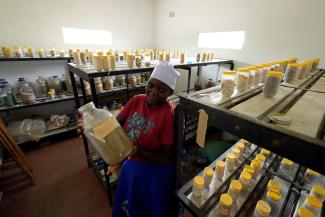Biodiversity
Seed banks preserve diversity
 picture-alliance/ASSOCIATED PRESS/Tsvangirayi Mukwazhi
Seed bank in Zimbabwe’s arid Rushinga district.
picture-alliance/ASSOCIATED PRESS/Tsvangirayi Mukwazhi
Seed bank in Zimbabwe’s arid Rushinga district.
An old economic adage warns: “Don’t put all your eggs in one basket.” But when it comes to agricultural production and securing the global food supply, we are doing just that. We are relying on wheat, rice, maize and potatoes, which together meet over two-thirds of global demand for calories. Agricultural production is geared towards uniformity and standardisation, and diversity is being lost at all levels: in cultivation systems, among crops and within crops.
The UN Food and Agriculture Organization (FAO) estimates that plant diversity in fields worldwide declined by 75 % in the past century. One of the most important foundations of human life is disappearing. Diversity is what allows organisms to adapt to changing environmental conditions. Only if we manage to reverse the trend will agriculture become more resource efficient, sustainable, climate resilient and productive.
Historical diversity
Over the course of 12,000 years, farmers have bred about 200,000 rice varieties, 120,000 wheat varieties, 4000 potato varieties, 7500 apple varieties and 3000 coconut varieties. All of them trace their ancestry back to wild ancestors. Apart from crops that are well known and appreciated worldwide, there are countless others that are more narrowly distributed. Examples are millet, black-eyed peas, sweet potatoes, amaranth and macadamia nuts. Other underresearched and undervalued crops include teff, fonio, Bambara groundnut, arracacha and star fruit.
The crop diversity that humans have created coexists with related wild species, which nature has produced over millions of years. The future of agriculture – and our food supply – depends on this immeasurable genetic wealth. Any single genetic trait of a plant can hold the key to meeting future challenges that we are not even aware of yet.
Therefore, we must do everything we can to preserve this genetic diversity. Doing so resembles a natural life insurance policy. The first step is to stop further loss of diversity, both in farmers’ fields and in the wild.
Strategies for diversity
Incentives for diversifying crops and the designation of protected areas for biodiversity have not made enough of an impact so far. Unfortunately, such “in situ” efforts will probably only have limited success in future too. For that reason, a second strategy to preserve agrobiodiversity should be pursued in tandem: conservation “ex situ” in seed banks.
Over the course of the last century, such “seed libraries” have been established all over the world. They have assembled a considerable amount of agrobiodiversity. However, they need support so that they can collect and save additional crops and varieties. Moreover, they must store wild relatives of crops before they are lost forever. The situation is becoming increasingly urgent as diversity is dwindling “in situ”.
Advantages of seed banks
Seed banks are knights in shining armour for our food systems. Their purpose is to help build resilient, sustainable agriculture. They are not only a destination for researchers and plant breeders but can also distribute high-quality seed to farmers and thus contribute to local agricultural development.
The advantages of seed banks are obvious. After an initial investment, the cost to maintain them is relatively low. Seed banks can deliver sufficient quantities of pest- and disease-free seeds across national borders all year long, independent of vegetation cycles. Well-managed collections remain stable over time, unlike varieties that are preserved under “in situ” conditions.
This means seed banks can provide raw material to breeding programmes, together with reliable – and easily accessible – data on each sample’s characteristics, so users can order precisely the materials they need. Ultimately, “ex situ” collections offer a “safety net”. They can bring locally adapted varieties back to fields where they have been lost, whether due to natural disasters or human intervention.
At the same time, it is important that crops keep evolving and adapting to changes in the living environment outside seed banks. Stored seeds do not interact with nature in an evolutionary dynamic. Valuable agricultural knowledge is lost when a variety is only conserved, but no longer cultivated.
National seed banks
According to the FAO, there are now more than 1750 gene banks around the world. Approximately 130 of them each contain over 10,000 genetically diverse seed samples, or so-called accessions. An estimated 7.4 million accessions are maintained worldwide. Most of the larger collections are managed at the national level. For instance, the national seed banks of Brazil, China, Germany, India, Japan, Canada, Russia, South Korea and the USA contain over 100,000 accessions each. National collections usually house a broad spectrum of plant-genetic resources of the most diverse varieties and species.
In contrast, seed banks that are linked to international research institutes often focus on a few important crops and their wild relatives. The most important institutes of this kind belong to the CGIAR (Consultative Group on International Agricultural Research) consortium. The diversity stored in their seed banks is considered a global public good, a “common heritage of humanity”, which the international community has given to the institutes to hold in trust.
The importance of secure seed banks was demonstrated when the important collection of the International Centre for Agricultural Research in Dry Areas (ICARDA) in Aleppo was destroyed during Syria’s civil war. Fortunately, ICARDA had previously deposited backup copies of its seeds in the Svalbard Global Seed Vault on Spitzbergen. Located north of the Norwegian mainland, the Svalbard Global Seed Vault stores samples under geologically stable conditions at a depth of 120 metres in permafrost. Thanks to the copies, ICARDA was able to resume its research and breeding work at new locations in Morocco and Lebanon.
Stefan Schmitz is the executive director of the Crop Trust, the international foundation dedicated to conserving crop diversity.
stefan.schmitz@croptrust.org


